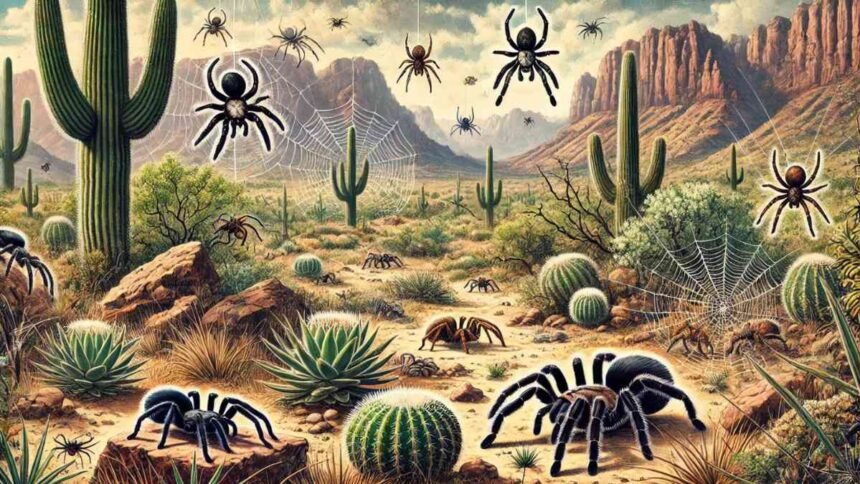Arizona is home to a wide variety of spider species, ranging from harmless orb-weavers to the more dangerous black widow. The state’s unique desert environment fosters an ecosystem where these spiders thrive, making it important for residents and visitors alike to understand how to identify common species. While most spiders in Arizona are not harmful, some can pose a threat, especially to those with allergies or compromised immune systems. Learning to coexist safely with Arizona spiders is essential for anyone living in or visiting this arid region.
Introduction: The Fascinating World of Arizona Spiders
Arizona’s desert landscape is home to a rich variety of spider species, each playing a vital role in maintaining the ecosystem. From the delicate web-spinners to the more robust ground dwellers, spiders contribute to controlling insect populations and promoting biodiversity. In this article, we’ll explore the types of spiders commonly found in Arizona, how to identify them, and what to do if you encounter one. While some species, like the black widow, are venomous, most Arizona spiders pose no significant threat to humans. This guide will help you understand these creatures and how to stay safe.
The Most Common Arizona Spiders
1. Black Widow Spider
The black widow spider is one of the most well-known venomous spiders in Arizona. Its shiny black body and distinctive red hourglass marking make it easy to identify. Black widows prefer dark, sheltered areas and are often found in garages, sheds, and wood piles. While their bites can be dangerous, they are not usually fatal with prompt medical attention. Symptoms include muscle pain, cramping, and weakness.
2. Arizona Brown Spider
Often mistaken for the more dangerous brown recluse, the Arizona brown spider is less venomous but can still cause serious symptoms in sensitive individuals. Found primarily in outdoor spaces, they tend to hide under rocks, logs, and debris. Their bite can result in mild to severe skin lesions, making it important to seek medical advice if bitten.
3. Tarantulas
While intimidating in size, tarantulas are generally docile and not aggressive toward humans. These large spiders are commonly seen during the monsoon season in Arizona. Their bites are similar to a bee sting and are not considered dangerous. Tarantulas primarily prey on insects and are more likely to flee than fight when encountered.
4. Orb-Weaver Spiders
These spiders are known for their intricate web designs and are a common sight in Arizona’s backyards and gardens. Orb-weavers are not harmful to humans and are beneficial for controlling insect populations. Their bright colors and large webs make them easy to spot, especially in the early morning when dew clings to their silk.
How to Identify Arizona Spiders
Identifying Arizona spiders can be a daunting task due to the sheer variety of species. However, focusing on a few key characteristics can help. Color, body shape, and web structure are good indicators of the spider’s species. For example, black widows are known for their shiny black bodies and red hourglass marking, while tarantulas have large, hairy bodies and are often brown or black.
Pay attention to where the spider is located. Certain species prefer specific habitats, such as black widows favoring dark, sheltered spots and orb-weavers building webs in open areas like gardens.
Are Arizona Spiders Dangerous?
While Arizona spiders may seem frightening, most are harmless to humans. Even the more dangerous species, like the black widow, rarely cause fatalities. The key to staying safe is knowing which spiders are venomous and how to avoid being bitten. In general, spiders are more interested in avoiding humans than attacking them. If you do encounter a venomous spider, remain calm and give it space to escape.
What to Do If You Are Bitten by an Arizona Spider
If you suspect you’ve been bitten by a spider, it’s important to assess the situation. Most spider bites are harmless and require no medical attention. However, if you experience severe pain, swelling, or other symptoms such as muscle cramps (which are common with black widow bites), seek medical attention immediately. Arizona brown spider bites can cause localized skin damage, and it’s essential to clean the wound to avoid infection.
Prevention Tips: Keeping Arizona Spiders Out of Your Home
To minimize the chance of encountering spiders in your home, take a few simple precautions:
- Seal cracks and gaps: Spiders often enter homes through small cracks around doors and windows. Sealing these entry points can help keep them out.
- Reduce clutter: Spiders like to hide in piles of clothing, boxes, and other clutter. Keeping your home tidy will reduce hiding places.
- Use screens: Installing screens on windows and doors can prevent spiders from entering.
- Keep outdoor areas clean: Regularly clearing leaves, wood piles, and debris from your yard will make it less attractive to spiders.
The Role of Spiders in Arizona Ecosystem
Spiders play an important ecological role in Arizona, especially in controlling insect populations. By preying on flies, mosquitoes, and other pests, spiders help reduce the spread of diseases and keep ecosystems balanced. In desert environments where food sources can be scarce, spiders are essential in maintaining the delicate balance of nature. Their presence ensures that other species, including humans, can thrive without being overwhelmed by insect pests.
Coexisting with Arizona Spiders: A Final Word
Living in Arizona means sharing your environment with its native spiders. While some may be venomous, the vast majority are harmless and play an important role in the ecosystem. Understanding how to identify common species and take precautions to avoid bites can make a big difference in how you feel about these eight-legged creatures. With the right knowledge, you can safely coexist with Arizona spiders and appreciate their place in the desert ecosystem.
For More Visit, Viraltimes.co.uk







